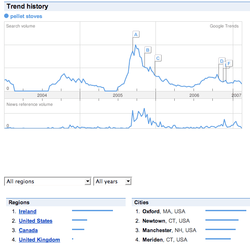Webmaster said:
Jabberwocky said:
what's the connection to Katrina? Actual power outage victims? Why would residents of LA and MS give a hoot about heating? Or was it people responding to the spike in oil and NG prices as a result of Katrina?
The weeks after Katrina were responsible for a rise in energy costs which fueled a new boom in Pellet stove sales and Wood Stove sales and interest. The media picked up on this - this is when I had the 3 page spread done on me in Kiplingers. Traffic to Hearth.com in Oct, 2005 remains our record-setter with about 450,000 readers that month alone.
What is interesting is that direct combustion of biomass has greater acceptance in many European countries and Canada resulting from their commitments to the Kyoto Protocol and higher traditional energy costs. Residential and Commercial space heating was given some greater focus over converting biomass into liquid fuels or electric generation compared to U.S. policy which has focused mainly on liquid biofuels. It is interesting to compare per capita use of Direct Combustion Appliances for residential and commercial space heating between the U.S. and leading European nations. There is a substantial gap evident in markets as a global market for pelletized biomass emerges in energy markets and international trade grows. For a transition to renewable energy to be successful in free markets and democratic societies, average consumers and citizens must find some reason to embrace the technology. In the U.S. the technology has been embraced over the past several years as traditional energy costs for electricity, propane, heating oil, kerosene, and natural gas have dramatically increased and grown more volatile offering significant cost savings for many consumers choosing to use direct combustion appliances. Based upon the market penetration of direct combustion appliances in these European markets, growing concern over carbon dioxide emissions, increasingly stringent Federal and State EPA regulations and community ordinances on particulate emissions from fireplace and stove use, and continued volatility in global energy markets I would think trends would continue to benefit direct combustion appliances and especially multifuel pellet appliances capable of burning wood pellets, corn, or other renewable fuels.
While many complain about higher prices for wood pellets, corn, and other biomass fuels, costs for these fuels also increase with higher traditional energy costs because production and distribution costs for these renewable energy sources are somewhat dependent on traditional energy sources. Dynamic price comparisons are critical because static models looking back at prices for biomass 5 or 10 years ago neglect the real effect of higher energy costs on the cost of production and distribution. A static focus on prices for pellets and corn that does not reflect rising cost of traditional energy and maintain a dynamic cost comparison is less than accurate. Compared to Electric-resistance, propane, heating oil, and kerosene wood pellets and corn can still provide better value for residential heating applications. Natural Gas is the most competitive traditional energy source but is under increasing pressure from demand and supply curves and more volatile in present energy markets. Based upon global energy markets and domestic U.S. energy markets greatly affected by and vulnerable to hurricane activity along the Gulf Coast I would suspect sales of multifuel pellet stoves has good potential to grow at the expense of traditional wood burning appliances which likely will face increasing regulation and restrictions on particulate emmissions.
Active hurricane season again predicted for the U.S. and we may not be so fortunate to dodge the bullet again this year following the virtually nonexistant hurricane season last year. Oil prices projected by some to reach $70-$80/barrel increasing the cost of heating oil and propane for next heating season. Electric rates climbing ever higher around the country and especially in some Midwestern states all seem to favor the competiveness of multifuel pellet appliances capable of burning wood pellets and corn. Even with higher market prices for these renewable energy fuels used in direct combustion appliances, consumers can still find substantial savings on energy costs for residential heating. The industry needs to become more proactive in developing supply of acceptable fuels and promoting the cost savings and environmental benefits for millions of American homes who do not have access to natural gas for residential space heating.
The savings are still there when energy costs are compared from a dynamic rather than static perspective. Americans need to decide where they would prefer the benefit of their energy dollars to go. The free market is offering new choices in renewable energy. Energy dollars can be spent to benefit Foreign Energy Cartels, Tyrants and Dictators, Big Oil, America's Adversaries or with renewable energy initiatives like direct combustion of biomass American's can spend energy dollars to benefit independent American Companies, American Farmers, and Rural American Economies where most wood pellets, corn, and other biomass originates while saving on their own energy costs. Renewable Energy Alternatives have real potential to contribute to a Rural Renaissance across America with direct combustion technology for use in residential and commercial space heating offering maybe the greatest benefit because the benefits are more direct between energy producers and consumers. The choice is ours.



